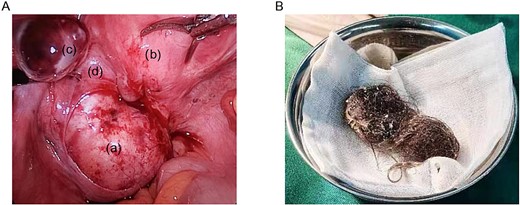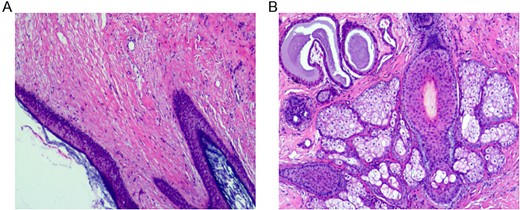-
PDF
- Split View
-
Views
-
Cite
Cite
Tingzhu Meng, Xueliang Lu, Dan Teng, Xin Li, Jie Shi, Mature cystic teratoma originating in the broad ligament: a case report, Journal of Surgical Case Reports, Volume 2024, Issue 10, October 2024, rjae661, https://doi.org/10.1093/jscr/rjae661
Close - Share Icon Share
Abstract
Teratomas are germ cell tumors, commonly affecting ovaries. Teratomas rarely affect extragonadal tissues. Few cases of teratomas occurring in extragonadal tissues have been reported in the past. However, no studies have reported cases of primary teratomas occurring in the broad ligament. In this study, we report a case of a sexually inactive young woman with a 3-day history of lower abdominal pain. B-ultrasound examination revealed an abnormal strong echogenicity mass in the left adnexal area. An exploratory laparotomy was performed on her. The surgery revealed normal size and appearance of both ovaries and uterus. However, a cyst was observed in the left broad ligament, which was diagnosed as benign mature teratoma based on pathology. In this study, we report a rare case of broad ligament teratoma. The clinical data enrich our understanding of teratomas and provide a reference for further studies.
Introduction
Teratomas result from the differentiation of germ cell tumors and comprise more than two dermal tissues. They can be classified into solid and cystic teratomas according to their appearance. Moreover, they can be group into mature and immature types based on the degree of tissue differentiation. Mature cystic teratomas account for ~95% of all teratoma cases [1]. Extragonadal teratomas primarily occur in various locations such as mediastinum, sacrocaudal, and peritoneum [2]. However, teratomas occurring in the broad ligament have not been reported. In this study, we report a case of a young woman with a mature teratoma in the broad ligament.

Intra-operative findings. (A) A cyst measuring about 6 × 6 × 5 cm is observed in the left broad ligament: (a) teratoma (b) uterus (c) ovary (d) broad ligament. (B) A significant amount of hair and grease are observed in the capsule cavity.
Case report
A female patient in her early 20s, with no unique medical history, attended our hospital with a 3-day history of low abdominal pain. The patient had regular menstruation, normal menstruation volume, and no dysmenorrhea. She had no history of surgery, acute or chronic pelvic inflammatory disease and was not sexually active. Gynecological B-ultrasound revealed a mass measuring 6 × 6 × 5 cm in the left accessory area with mixed echogenicity. Other examination results were within the normal range. The patient was informed of the condition and risk before signing an informed consent form for a surgery. The patient underwent exploratory laparotomy. The surgery revealed that there was no pelvic adhesion, and the patient’s uterus was normal in size, with a smooth surface and no vegetation. Bilateral ovaries and fallopian tubes appeared normal without any detectable mass. A cyst measuring ~6 × 6 × 5 cm was observed in the left broad ligament. The surface of the cyst was smooth. The base of the cyst was located in the left broad ligament and it did not extend into the broad ligament. The whole cyst was not connected to the left ovary and uterus (Fig. 1A). Complete tumor resection was performed and the cyst did not rupture during the resection. The lump was incised and its capsule wall opened. The capsule wall was smooth and the capsule cavity had a lot of hair and grease (Fig. 1B). The cyst was diagnosed as mature teratoma by two senior pathologists (Fig. 2). The definite diagnosis was a teratoma of broad ligament. After the operation, the patient recovered well, was discharged without complications, and has remained in good condition during follow-up.

Discussion
Teratomas are relatively common germ cell tumors. The clinical manifestations of teratomas are related to the tumor size and whether the tumor compresses adjacent organs [3]. Some patients have no symptoms and the cysts are only detected through imaging examination. Teratomas are often located in the genital glands, with some rare cases in the corpus uteri, uterine cervix, ventricular, stomach, lung, and rectum (Table 1). The clinical manifestations, diagnosis and postoperative treatment of this patient were not unique to the mature cystic teratomas located in the ovary. Notably, the patient was not sexually active, the ovary was normal without cysts, and the cyst did not adhere to the pelvic cavity. The teratoma was only located in the broad ligament. Currently, the etiology of broad ligament teratoma is unknown. However, several theories on the etiology of uterine teratomas have been proposed. For sexually inactive patients, the theory proposes that uterine teratomas are primarily caused by abnormal entry of primordial germ cells into the uterus during the early embryonic development process [13]. This theory may partially explain the tissue origin of broad ligament teratomas. At present, no research has reported broad ligament teratomas. Therefore, there is no internationally accepted standard for the treatment and prognosis of broad ligament teratomas. Notably, the histological changes of this teratoma are not unique. Consequently, the pathological diagnostic criteria can be based on the WHO histological classification criteria of ovarian teratomas. It is uncertain whether the patient will relapse or exhibit malignant symptoms after surgery, due to lack of clinical data on similar cases. In this study, we report a rare case of broad ligament teratoma. The findings enrich our understanding of teratomas and provide first-hand clinical data. The patient did not relapse after >1 year of follow-up, and follow up is ongoing.
| Location . | Age . | Pathology . | Follow-up . | Reference . |
|---|---|---|---|---|
| Corpus uteri | 11-year-old | Immature teratoma | No recurrence during 2 years | [4] |
| Uterine cervix | 13-year-old | Immature teratoma | Not reported | [5] |
| Interventricular | 7-year-old | Mature teratoma | No recurrence | [6] |
| Stomach | 6-year-old | Mature teratoma | No recurrence | [7] |
| Lung | 37-year-old | Mature teratoma | No recurrence during 1 year | [8] |
| Rectum | 68-year-old | Mature teratoma | Not reported | [9] |
| Pharynx oralis | 5-month-old | Benign teratoma | No recurrence during 18 months | [10] |
| Orbit | 6-month-old | Mature teratoma | Not reported | [11] |
| Pancreas | 33-year-old | Mature teratoma | No recurrence | [12] |
| Location . | Age . | Pathology . | Follow-up . | Reference . |
|---|---|---|---|---|
| Corpus uteri | 11-year-old | Immature teratoma | No recurrence during 2 years | [4] |
| Uterine cervix | 13-year-old | Immature teratoma | Not reported | [5] |
| Interventricular | 7-year-old | Mature teratoma | No recurrence | [6] |
| Stomach | 6-year-old | Mature teratoma | No recurrence | [7] |
| Lung | 37-year-old | Mature teratoma | No recurrence during 1 year | [8] |
| Rectum | 68-year-old | Mature teratoma | Not reported | [9] |
| Pharynx oralis | 5-month-old | Benign teratoma | No recurrence during 18 months | [10] |
| Orbit | 6-month-old | Mature teratoma | Not reported | [11] |
| Pancreas | 33-year-old | Mature teratoma | No recurrence | [12] |
| Location . | Age . | Pathology . | Follow-up . | Reference . |
|---|---|---|---|---|
| Corpus uteri | 11-year-old | Immature teratoma | No recurrence during 2 years | [4] |
| Uterine cervix | 13-year-old | Immature teratoma | Not reported | [5] |
| Interventricular | 7-year-old | Mature teratoma | No recurrence | [6] |
| Stomach | 6-year-old | Mature teratoma | No recurrence | [7] |
| Lung | 37-year-old | Mature teratoma | No recurrence during 1 year | [8] |
| Rectum | 68-year-old | Mature teratoma | Not reported | [9] |
| Pharynx oralis | 5-month-old | Benign teratoma | No recurrence during 18 months | [10] |
| Orbit | 6-month-old | Mature teratoma | Not reported | [11] |
| Pancreas | 33-year-old | Mature teratoma | No recurrence | [12] |
| Location . | Age . | Pathology . | Follow-up . | Reference . |
|---|---|---|---|---|
| Corpus uteri | 11-year-old | Immature teratoma | No recurrence during 2 years | [4] |
| Uterine cervix | 13-year-old | Immature teratoma | Not reported | [5] |
| Interventricular | 7-year-old | Mature teratoma | No recurrence | [6] |
| Stomach | 6-year-old | Mature teratoma | No recurrence | [7] |
| Lung | 37-year-old | Mature teratoma | No recurrence during 1 year | [8] |
| Rectum | 68-year-old | Mature teratoma | Not reported | [9] |
| Pharynx oralis | 5-month-old | Benign teratoma | No recurrence during 18 months | [10] |
| Orbit | 6-month-old | Mature teratoma | Not reported | [11] |
| Pancreas | 33-year-old | Mature teratoma | No recurrence | [12] |
Acknowledgements
T.M. would particularly like to acknowledge all of their teammates for their wonderful collaboration and patient support.
Author contributions
Conceptualization: TingZhu Meng, XueLiang Lu, Jie Shi.
Data curation: Dan Teng, Xin Li.
Writing—original draft: TingZhu Meng.
Writing—review & editing: Jie Shi.
Conflict of interest statement
None declared.
Funding
This work was supported by Hubei Provincial Health Commission Joint Project WJ2019H295.
Data availability
Data sharing is available upon reasonable request from the corresponding author.
Informed consent
Informed consent for publication was not applicable because we have de-identified all of the patient’s details.



